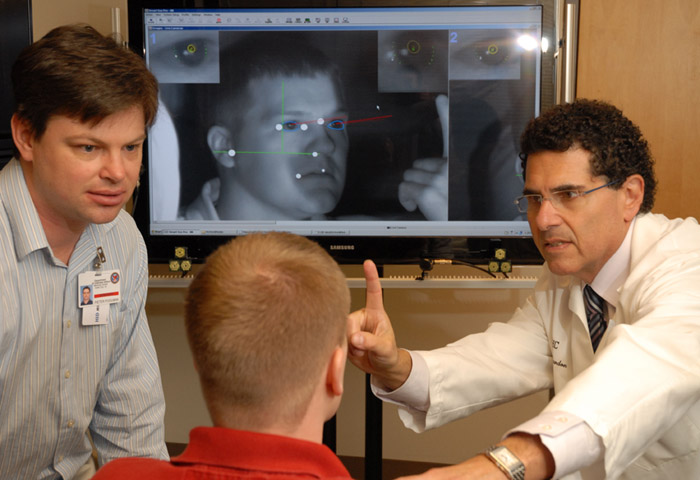New Military Medical Research Focuses on Saving War Fighters' Sight

Today's war fighters face numerous threats to their vision, from blast injuries to chemical, biohazard, laser and environmental exposure injuries. According to the National Alliance for Eye and Vision Research, traumatic eye injury from penetrating wounds and visual disorders related to brain injury together rank as the second most common injury among active military. Compounding the problem, eye-injured soldiers have only a 20 percent return-to-duty rate as compared to an 80 percent rate for other battle trauma injuries.
The U.S. Army Medical Research and Materiel Command's Telemedicine and Advanced Technology Research Center is funding a group of research projects that constitute a multidisciplinary, integrated approach to preventing and treating vision disorders. It is collaborating with universities and research institutes throughout the world in this effort.
"We've purposefully funded these projects as a group because we believe they will work together most quickly and effectively to develop treatments and products to save the sight of our war fighters," says TATRC director Col. Karl Friedl.
The TATRC projects specifically address critical gaps in vision research, including treatments for war-related eye trauma, vision rehabilitation strategies, ocular diagnostics, diagnosis and treatment of brain injury-associated visual dysfunction, computational models of battlefield injuries, and vision restoration through regeneration and neurological prostheses.
"Each partner is working on a very important piece of the puzzle," says Robert Read, who manages TATRC's vision research portfolio. "We planned the portfolio to cover nine critical gaps. We chose these 12 recipients from 120 research submissions because they best address these critical areas."
The most recent projects began at the end of 2010. They include:
Quick and Portable Tests for Early Diagnosis of Vision Problems Related to Cognitive Impairment
The key to restoring sight after a blast injury is early diagnosis and treatment. Dr. Randy Kardon of the University of Iowa and Dr. Yury Petrov of Northeastern University are developing tests that use the eye's natural reflexes to determine the extent of visual processing disorders. Kardon's uses eye-tracking technology developed for gaming and is geared toward a smart phone application.
Dr. Stacey Choi of the New England College of Optometry is combining new optical technology with current retinal imaging systems to detect changes at the back of the eye at the cellular level. Due to its sensitivity, this imaging technique could be valuable as a diagnostic tool in situations where a blast was too weak to cause damage detectable by standard screening standards, yet visual symptoms exist.
RNA Treatment Therapies
In this promising area, researchers are hoping to develop drugs that use interfering RNA (a type of genetic material) to inactivate specific genes that regulate cellular processes involved in injury. Drs. Colin Doherty and Peter Humphries of St. James Hospital, Ireland, are seeking to modulate the blood brain barrier to reduce dangerous brain swelling and thus treat visual dysfunction associated with brain injury. Dr. Gregory Schultz of the University of Florida is applying RNA technology to reduce corneal scarring and resulting vision loss after burn and blast injuries. Dr. Nicholas Brecha of the University of California Los Angeles is exploring ways to reduce excessive intracellular calcium levels to slow or stop loss of vision in traumatic optic neuropathies. Optic nerve injuries are not always immediately detected and treated because there is often no visible damage.
Other Treatments for Vision Disorders
Dr. Kenneth Ciuffreda of the State University of New York College of Optometry and Dr. Uri Polat of Tel Aviv University, Israel, are exploring rehabilitative behavior-training therapies for visual disorders associated with brain injury. Dr. James Weiland of the University of Southern California is working on a project similar to synthetic vision work in aviation, exploring how to render visual information to an individual in a nonvisual way. Weiland's project is unique because it uses artificial intelligence to help a person determine what input is most important to pay attention to (say, a moving car as opposed to a background building).
Computational Models of Blast Injury to the Eye
Understanding the mechanism of injury has great potential value in preventing and treating vision loss. Models could also be used to evaluate protective eyewear. Investigators developing computational models include Dr. Thao Nguyen of Johns Hopkins University, Dr. Tonia Rex of the University of Tennessee and Dr. Richard Regueiro of the University of Colorado.
The above projects are funded through the Peer Reviewed Vision Research Program line item in the Defense Appropriations portion of the federal budget. "This line includes vision research that is not conducted by the Veterans Administration, elsewhere within the DoD, or by the National Eye Institute within NIH," says James Jorkasky, executive director of the National Alliance for Eye and Vision Research. "It addresses immediate battlefield needs."
TATRC manages the VRP as well as vision research funds from MRMC's Clinical and Rehabilitative Medicine Research Program. Read notes, "These funds support peer-reviewed projects carefully chosen to address identified research gaps. We are fortunate to have a team of national experts advising us clinically and scientifically."
Those involved in strategic planning and execution of the vision portfolio include Col. Donald Gagliano and Dr. Robert Mazzoli, director and deputy director of the DoD/VA Vision Center of Excellence; Walter Reed Comprehensive Ophthalmologist Lt. Col. Michael Mines; TATRC senior scientist Dr. Francis McVeigh, OD; and Marc Mitchell, GOR and project officer.
At least $7 million has been added to the portfolio for fiscal year 2011. Says Friedl, "In this time of closely examining the federal budget, this is a relatively small investment that could produce immense future savings, not only in healthcare costs but through maintaining military personnel as active, productive members of our nation's fighting force and workforce."














